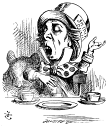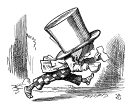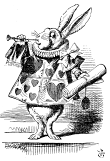Search us!
Search The Word Detective and our family of websites:
This is the easiest way to find a column on a particular word or phrase.
To search for a specific phrase, put it between quotation marks. (note: JavaScript must be turned on in your browser to view results.)
Ask a Question! Puzzled by Posh?
Confounded by Cattycorner?
Baffled by Balderdash?
Flummoxed by Flabbergast?
Perplexed by Pandemonium?
Nonplussed by... Nonplussed?
Annoyed by Alliteration?

Don't be shy!
Send in your question!
Columns from 1995 to 2006 are slowly being added to the above archives. For the moment, they can best be found by using the Search box at the top of this column.
 If you would like to be notified when each monthly update is posted here, sign up for our free email notification list.
If you would like to be notified when each monthly update is posted here, sign up for our free email notification list.
Trivia
All contents herein (except the illustrations, which are in the public domain) are Copyright © 1995-2020 Evan Morris & Kathy Wollard. Reproduction without written permission is prohibited, with the exception that teachers in public schools may duplicate and distribute the material here for classroom use.
Any typos found are yours to keep.
And remember, kids,
Semper Ubi Sub Ubi
|
But I was really good at 52 Pick-up.
Dear Word Detective: Early in Dickens’ Great Expectations, when Pip first meets Estella, she exclaims in dismay, “He calls the knaves, Jacks, this boy!” This got me to wondering why the King and Queen should have a knave as their constant companion, how he came to be called the Jack, and whence the class distinction between the two terms. This might not even be a word origins question, but I’ll bet you know the answer. — Harold Russell.
That’s an optimistic but not unreasonable bet, although I must tell you that I just called my broker and short-sold myself on this one. But my answer, even if hilariously wrong in the parts that make any sense at all, won’t be a total loss. I plan to bundle all my flops into a book at year’s end and sell it on Amazon. I already have friends lined up to give it four-star reviews, the cover, featuring Anna Chapman in a deerstalker and cape, is awesome, and Angelo Mozilo has promised to write the foreword.
Y’know, come to think of it, book publishing does bear an uncanny resemblance to the whole collateralized debt con. Perhaps that’s why my agent lives in the Hamptons and I, to put it mildly, don’t.
Onward. This is the point when I caution that my only experience with playing cards was an inexplicable winning streak in Go Fish when I was eight. I don’t even know how to play Solitaire. Yes, I am sad. But I do know that the terms “knave” and “jack” in cards both refer to the lowest-ranking court card in each suit, just below the King and Queen.
The “knave” cards in a modern deck of cards usually depict a rather dashing fellow, in full face or profile depending on the suit, nattily attired but absent the crown worn by the King and Queen. The “knave” is actually a young man or boy serving as an attendant in the royal court, which fits nicely with the original meaning of “knave.” Derived from Germanic roots, “cnafa” in Old English meant “a boy, a young male servant,” and in modern English its descendant “knave” settled into meaning “a male servant, usually of humble origin and menial station” (as opposed, for instance, to a knight). “Knave” in this sense was a fairly neutral term, but gradually underwent a process of “pejoration” and took on its modern meaning of “scoundrel, unscrupulous man” probably due to class prejudice against the low origins of most knaves. Interestingly, both the “court servant” and “dishonest creep” senses of “knave” were in use when the character of a knave first appeared on playing cards in the mid-1500s, but the card name definitely reflected the dutiful kind of “knave,” a recognized member of the royal court.
“Jack” is a familiar form of the common proper name “John,” and has long been used as a stand-in name for “the common man,” just about any worker (as in “lumberjack,” “steeplejack,” etc.), and even common tools (as in the “jack” that lifts a car). The use of “jack” as an alternative name for the “knave” on playing cards first appeared around 1674, or just a century after the “knave” itself appeared in the deck. That was, oddly enough, also just about a century after “jack” had undergone a process of “pejoration” parallel to that of “knave” and was commonly used to mean “a low-bred or ill-mannered lout.”
While “knave” and “jack” were used as names for the same playing card, “knave” was long considered the more “proper” name for the card (and still is more commonly used in Britain), most likely because it reflects an awareness of the original royal court origin of the character. “Jack” by that time had already been in use for so long in various forms of slang that even if it didn’t conjure up visions of a ruffian, it probably still reeked of the streets to many people. Thus Estella, adopted daughter of the extremely proper Miss Havisham, would have considered Pip’s use of the term “jack” an amusingly lower-class locution, worthy of her derision.
What I really need is a liger.*
Dear Word Detective: Any dog owner can well-understand such metaphors as “dogs” for feet (especially dog-tired feet), “dogging” somebody for pestering them, and even “dirty dog” (when I see my best friend rolling in the grass, I know it is bath time). But “dogs of war” for soldiers? I know it comes from Shakespeare, but did he make it up out of whole cloth? Was it a pure metaphor from having seen vicious dogs fighting? Or did they train attack dogs way back then? — Steve Ford.
So when they roll in the grass, that means they need a bath? Live and learn. I always figured they cleaned themselves, like cats do. Just kidding, of course, but I did discover a few years ago that dogs are much easier to bathe if you shave them first. Last summer I gave Pokie a lion cut, with a regal mane and just a tuft of fur left at the tip of her tail. People love lion dogs. There was one that used to live near us in Manhattan, on West 83rd Street, and guys sitting out on their stoops would shout, “Here comes the lion dog!” Then again, I think that dog’s owner was a drug dealer, so maybe they weren’t really excited about the lion dog, per se. But it was a cool dog.
I haven’t done a rigorous count, but I’d be surprised if there weren’t more phrases and idioms in English involving dogs than any other animal, although cats are obviously also very popular, followed by the ever-popular livestock idioms. But from “dog eat dog” to “a dog’s life” (not a happy one) to “dogleg” (a sharp bend in something) to “hair of the dog that bit you” (a hangover remedy containing alcohol) to “putting on the dog” (possibly from aristocrats who carried small dogs as fashion accessories) to “going to the dogs” (falling to ruin, but originally, according to Plutarch, simply meaning “in an uproar”), it’s apparent that man’s best friend is also man’s most convenient metaphor. The Oxford English Dictionary (OED) mentions a nifty one I’d never heard, “to keep a dog and bark oneself,” meaning “to do the work for which one employs others” (“Investors can monitor their portfolios … but mainly let the chosen professionals do their job. After all, why keep a dog and bark yourself?” UPI, 2001). Words to live by, if you can afford them. I guess the rest of us will have to go bark ourselves.
The phrase “dogs of war” does indeed come from Shakespeare’s play Julius Caesar, Act III, in Mark Antony’s soliloquy after Caesar’s assassination. Consumed by foreboding after the murder, Antony predicts chaos for Rome as Caesar’s legacy: “And Caesar’s spirit, ranging for revenge, With Ate by his side come hot from hell, Shall in these confines with a monarch’s voice, Cry ‘Havoc,’ and let slip the dogs of war.” (Ate, incidentally, was a Greek goddess who personified ruin and destruction.)
By “dogs of war” Shakespeare meant destruction, chaos and death on a mass scale, but he was aware, in concocting the metaphor, that dogs had been used in warfare since ancient times, including in Greece, Rome and even Egypt. As sentinels and guards outside encampments, scouts and trackers, and even as weapons of attack, dogs have been employed by armies just about as long as there have been armies, and many military forces (including those of the US) still use dogs for a variety of tasks.
In using the concrete “dogs of war” as a metaphor for the chaos of warfare, Shakespeare created a powerful and vivid phrase, which, not surprisingly, tends to pop up whenever essayists bemoan humanity’s predilection for self-destruction. But the publication in 1974 of Frederick Forsyth’s novel The Dogs of War gave a new currency and a slightly different meaning to the phrase. In Forsyth’s book, set in post-colonial Africa, the “dogs of war” are professional mercenaries, soldiers-for-hire hired by a British industrialist to overthrow the government of a country in order to gain access to its mineral wealth. The popularity of Forsyth’s book and its subsequent Hollywood film adaptation popularized the phrase “dogs of war” as a synonym for “mercenaries” or, a bit more loosely, “enthusiastic and amoral proponents of military action.” Oddly, neither definition has yet made it into the OED.
Incidentally, “to cry havoc” in Shakespeare’s time (and Caesar’s, too) was a specific military command ordering soldiers in battle to loot and seize spoils from the enemy. “Havoc,” from the Old French “havot” (looting), may have been derived from the Latin “habere,” to have.” Shakespeare’s use of the phrase as part of his metaphor probably contributed to the broadening of “havoc” (often combined with “play” or “wreak”) to its modern meaning of “confusion, disorder, or destruction” (“The noise and clatter of high-revving engines can play havoc with a driver’s nerves,” 1969).
—–
* Napoleon Dynamite: It’s pretty much my favorite animal. It’s like a lion and a tiger mixed… bred for its skills in magic.
Now we avoid looking directly at it and leave an offering of carrots once a week.
Dear Word Detective: What is the origin of the term “hairbrained”? Which is the correct spelling: “hairbrained” or “harebrained”? — Lori Cash.
Aw, gee, why ask me when we have the internet? I’ll just plug “hairbrained” into Google News and push the magic button. Hmm, 43 hits, which isn’t a lot, but some of them are for reputable sites such as The Los Angeles Times (“The concert’s punk portion consisted of happily hair-brained and hair-raising arrangements…”), Discovery News (“Sounds like a hair-brained theory…”), and Esquire (“Torio takes a fatherly approach with the dim-witted Al, urging him to ‘leave him out’ of Al’s hair-brained schemes.”). The LA Times citation might, of course, be a lame pun, but the others are apparently guileless uses of that spelling. “Harebrained,” on the other hand, garners 127 results, many of which are from similarly august sources (“And yes, some of what he spouts is harebrained,” Washington Post). Hyphenation of both spellings, incidentally, varies.
So I assume we can agree not to let Google pick our next president, and now it’s time to open the envelope. The etymologically proper spelling is “hare-brained,” and the Oxford English Dictionary (OED) seems to prefer that hyphenated form, although Merriam-Webster likes “harebrained,” as do I.
I said that “harebrained” was the “etymologically proper” spelling because the logic of “harebrained” is that the person so described acts as if he or she had no more brains or sense than a “hare,” which is, of course, an animal similar to, somewhat larger than, but not usually considered notably smarter than, the common rabbit. The product of such low-wattage thinking can also be rightly described as “harebrained,” as in the ever-popular “harebrained scheme.”
Ironically, in the mythologies of several cultures around the world, the hare is portrayed as a “trickster,” a supernatural entity which plays tricks on people, which would imply high intelligence. We happen to have a large stone figure of a hare outside the door to our house, which may be why the internet and telephone keep going out. But the thing is way too heavy to move, and anyway I’d be afraid of annoying it.
Probably the most famous hare in literature is the March Hare of Lewis Carroll’s Alice’s Adventures in Wonderland, named from the old English folk-saying “Mad as a March hare,” meaning very mad (insane) indeed. Hares mate in the spring, and the saying refers to their highly agitated dating behavior during the month of March. Our modern English word “hare” (in Old English, “hara”) comes from Germanic roots, possibly carrying the sense of “gray,” which many hares are. The adjective “harebrained” first appeared in written English in 1548, simultaneously with the appearance of the noun “harebrain,” meaning a witless or reckless person.
Many words change their spellings over time, and “hare” is among them. (You can see where this is going, can’t you?) The first citation for “harebrained” in the OED is from 1548 (“My desire is that none of you be so unadvised or harebrained as to be the occasion that [etc.]”). The second citation is from 1581, and contains something interesting: “If his sonne be haughtie, or haire brained, he termeth him courageous.” Yup, “haire brained,” because early on “hair” was an accepted spelling of “hare,” and this spelling remained common in Scotland well into the 18th century. Examples in the OED alternate between the “hare” and “hair” spellings, including “hair” samples from such un-harebrained writers as the great essayist William Hazlitt (“The excesses of mad, hairbrained, roaring mirth,” 1818).
If you’re feeling charitable (and credulous) at any given moment, you might imagine that people who spell “harebrained” as “hairbrained” today are simply employing this antiquated Scots spelling, perhaps even jonesing for some tasty haggis while they do so. But it’s far more likely that they’re laboring under the impression that the word implies that the “hairbrained” person has a head full of light, fluffy and useless hair where their brains should be. Given our culture’s obsession with hair, that’s entirely understandable, but it’s still off the mark. I suggest we stick with “harebrained,” even if in doing so we risk the wrath of hares.
|
Makes a great gift! Click cover for more.  
400+ pages of science questions answered and explained for kids -- and adults!
FROM ALTOIDS TO ZIMA, by Evan Morris
 
|


 can be found
can be found 




Recent Comments